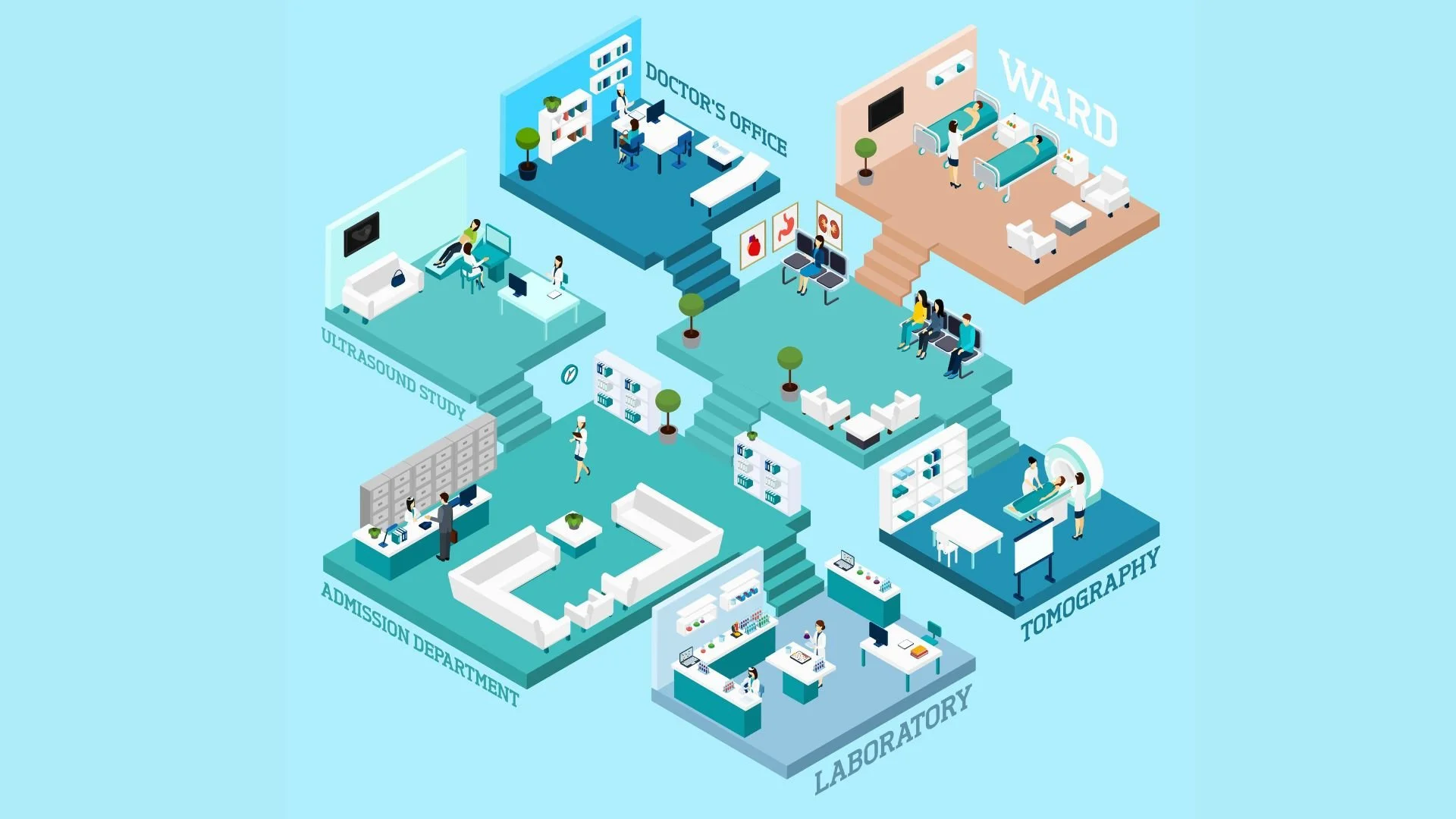Space as Strategy: Why Slimming Hospital Layouts Pays Off
By Arunima Rajan
In an interview with Arunima Rajan, Arti Gugnani, Partner, Vijay Gupta Architects (VGA) talks about why less is more in healthcare design.
You say “less is more” is not just about looks but a real need in hospital design. How does cutting down on clutter and focusing on simplicity lead to better patient care and smoother operations?
When we follow the “less is more” philosophy in hospital design, it goes beyond aesthetics to become a practical approach to improving how hospitals function. By simplifying spatial layouts and eliminating unnecessary complexity, we create environments where the movement of all stakeholders—outpatients, inpatients, medical staff, and visitors—is streamlined and intuitive.
This deliberate clarity in circulation patterns minimises cross-movement, which is essential for infection control. As a result, patient outcomes improve, and hospital operations become significantly more efficient.
Hospital CEOs often struggle with efficiency. From a design point of view, how do you make sure a hospital simply works better? Any examples from your own projects?
Efficiency in hospitals starts with clarity in planning. At Buddha Medicity in Gorakhpur, for instance, we designed the hospital around a central linear circulation spine, with departments arranged perpendicularly in a modular fashion. This layout simplifies the navigation for patients and staff and also ensures clarity in spatial hierarchy. Vertical zoning is implemented based on the intensity of use—for example, diagnostic services are positioned at the ground or basement level with direct external access. The outpatient department (OPD) is entirely on the ground floor, day care services on the first floor, general wards on the second, private rooms on the third, intensive and critical care units on the fourth, and operation theatres on the fifth floor. This rational stacking enhances operational efficiency and user comfort.
There is growing evidence that natural light, greenery and calm spaces help patients heal faster. How do you bring this into hospital design, and what changes have you seen in patient outcomes?
This is something I relate to deeply, having personally experienced the emotional and physical toll of long-term hospitalisation as a caregiver to my parents. The simple act of looking out at the sky, witnessing sunlight filtering through leaves, or catching a glimpse of open green spaces had a noticeably calming effect—not just on them, but on me as well. In our design for Buddha Medicity, every patient room has been oriented to overlook landscaped open spaces, allowing ample natural light to filter in. Such design decisions contribute significantly to lowering stress levels, promoting healing, and creating a more humane hospital environment.
Hospitals can be confusing, especially when people are stressed. How do you design spaces that feel intuitive to navigate without making them feel clinical or overwhelming?
We prioritise intuitive circulation through simplified and well-defined movement paths. Natural light is used generously to orient and comfort users. Additionally, acoustics are carefully controlled to reduce noise, while calming colours and materials are selected to soften the environment. Landscaped areas are integrated wherever possible to offer moments of relief and grounding. Together, these choices create a space that supports patients and visitors during times of vulnerability.
With hospitals becoming more high-tech, how do you balance technology with human-centric spaces? How do you make sure hospitals stay welcoming even with all the tech?
Technology plays a pivotal role in enhancing medical outcomes, but we must never lose sight of the fact that hospitals exist to serve human beings in distress. The healing process is not purely medical; it is also psychological. The synergy between high-performance healthcare technology and calming, human-centric spaces can dramatically amplify recovery rates. Our design philosophy ensures that the benefits of technology are complemented, not overshadowed, by an environment that supports emotional well-being.
Budgets are tight for many Indian hospitals. How can smart design choices save costs without cutting back on quality or patient care? Can “less is more” actually help hospitals grow without overspending?
Absolutely. Good design is not synonymous with expensive design. On the contrary, it should lead to cost efficiency. By rationalising architectural forms, optimising structural spans, and reducing unnecessary service redundancies, we can significantly lower costs while maintaining the highest standards of patient care. The “less is more” approach helps institutions grow responsibly, maximising the utility of each square foot, while staying within budgetary constraints.
Every hospital leader today wants to build for the future. What are the design decisions you make now so hospitals stay flexible and ready for tomorrow’s challenges?
Future-readiness in hospital design stems from flexibility and scalability. This is achieved through simple, modular layouts anchored on a consistent structural grid. We avoid superfluous ornamentation and instead focus on adaptable planning, use of economical and lightweight materials, and spatial configurations that can evolve with changing healthcare needs. These are fundamental principles that apply not just to hospitals, but to all forward-looking architecture.
You worked on Buddha Medicity with a simple, clean layout to ease patient movement and operations. What specific problems were you solving with this design?
Our primary goal was to enable seamless circulation for all user groups—patients, caregivers, medical staff, and service personnel. By minimising unnecessary overlap in movement and isolating non-public areas from high-traffic zones, we were able to enhance operational efficiency and improve infection control. The simplicity of the layout also makes orientation easy, especially for first-time visitors.
If a hospital CEO cannot do a full renovation right away, what small, practical changes can they make to improve the space for patients and staff?
Small, strategic changes can have a significant impact. Upgrading lighting to ensure well-lit spaces, choosing a softer, calming colour palette, improving acoustics to reduce ambient noise, and adding greenery—even if just a few potted plants—can transform the experience of a hospital without major renovation. These elements improve the emotional and sensory environment for both patients and staff.
Looking ahead, where do you see hospital design heading in India? What trends or shifts should hospital leaders keep an eye on if they want to stay ahead?
Hospitals are complex ecosystems where highly emotional, time-sensitive, and critical interactions take place. Design should aim to simplify, not complicate, these interactions. The future lies in creating spaces that are intuitive, calming, and spatially efficient—spaces that prioritise the patient as a human being, not just a case file. I believe the next generation of hospital design in India must realign itself with the core values of empathy, clarity, and adaptability. For hospital leaders, the shift is clear: the human experience of healthcare must be placed back at the centre of all decision-making.
While you emphasise balancing technology with human-centric spaces, could you give specific examples of how you've integrated modern medical equipment or digital systems without compromising the welcoming atmosphere?
Technology today is an essential part of hospital infrastructure, whether it’s MRI and CT machines or advanced surgical equipment. These elements are considered right from the planning stage, with the design accommodating their technical requirements seamlessly within the spatial layout. When integrated well, technology doesn’t feel like a separate or disruptive entity. Instead, it enhances the hospital’s efficiency and brings a sense of order to the environment, supporting patient care without compromising the calm, welcoming atmosphere that a healing space should offer.
Buddha Medicity appears to be a large facility. How can smaller district hospitals or nursing homes with limited budgets and space adopt these principles? Can you share examples from smaller projects?
In my experience, effective hospital design doesn’t necessarily rely on scale or budget—it depends far more on clarity of planning and a deep understanding of how a hospital functions day-to-day. At Ashirvad Hospital in Varanasi and SKG Hospital in Jodhpur—both 100-bed facilities in smaller urban centres—we applied the same core principles of zoning and circulation that guide our larger institutional projects.
By vertically stacking programmatic functions based on frequency of access and privacy needs, we created a rational, intuitive flow through the hospital. Services such as diagnostics and operations were placed at the core for ease of access and compact service distribution, while patient rooms were located along the periphery to benefit from natural daylight, ventilation, and external views.
This rational segregation enhanced operational efficiency and contributed significantly to patient well-being and staff comfort. When done with intention, even modest hospitals can be the most effective.
How do your "less is more" designs hold up over time? What about maintenance costs, energy efficiency, and environmental sustainability aspects?
The “less is more” philosophy naturally aligns with sustainability. By simplifying forms, reducing material redundancy, and avoiding unnecessary detailing, we create buildings that are not only easier to maintain but also better able to withstand the test of time.
Indian hospitals serve diverse populations with varying cultural needs. How do you accommodate requirements like space for large family groups, prayer areas, or dietary considerations in your minimalist approach?
Indian hospitals serve a diverse cross-section of society, and our designs reflect that reality. Shared spaces are designed to be generous—larger corridors, courtyards, and spill-out areas give families room to wait, gather, or reflect. These in-between spaces are just as important as patient rooms, offering flexibility and comfort in moments of uncertainty. Sensitivity to how families engage with space ensures that our hospitals remain inclusive and culturally grounded.
Have you faced any conflicts between your design philosophy and Indian healthcare regulations or building codes? How do you navigate these?
Healthcare has its own set of stringent norms, and rightly so. We’ve always seen these regulations not as limitations but as frameworks that help us make better, safer buildings. Rather than seeing them as a hurdle, we use them to guide our designs toward clarity, efficiency, and long-term functionality.
Hospital administrators need to justify investments. Can you provide specific return-on-investment examples where your design choices led to measurable financial benefits—reduced operational costs, increased patient throughput, or higher revenue per bed?
As the Buddha Medicity project is yet to be completed, we don’t have definitive numbers to share at this stage. However, the design intent has always been to create long-term operational efficiencies through modularity, rational stacking, and resource-conscious detailing, which we believe will translate into measurable ROI.
Got a story that Healthcare Executive should dig into? Shoot it over to arunima.rajan@hosmac.com—no PR fluff, just solid leads.

